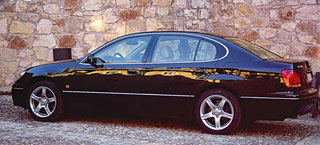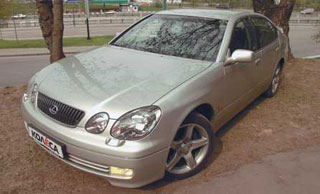Test drive Lexus GS 2000 - 2005 sedan
Call to the titans
In the modern automotive world with titans, you can compare the two best, perhaps, size sedan of Mercedes-Benz and BMW 5th series. This couple have rivals that stars in the sky. Some, like Alfa-Romeo-166 and Peugeot 607, are trying to lure the client with external grace, others, such as Opel-Omega and Nissan-Maxim-QX, relative cheapness, others SAAB-9-5 and Volvo-S80 are focusing on active security .But the heart is in the heart, we admit: not one of the listed models was able to get close to the bastions of German sedans. However, sooner or later there is its own Zeus for any titanium. More recently, the updated Lexus-GS430 sedan, well familiar in the New World, made their debut in the European market. After two days of acquaintance with this car on the roads of East Germany, I am almost sure that the Japanese is quite capable of if you do not overthrow the titans, then at least become in one row with them.
After the victorious blitzkrrig in the United States, the luxury brand Toyota Motor Corporation Lexus closely took up the expansion in the Old World. Three main blows. In the class of compact athletes, the IS200 model is attacking, the parquet road workers should rebel the updated RX300, but in the highest segment of class E Nadezhda Lexus is associated with GS300/430 models.
The large GS430 sports sedan is not distinguished by outstanding external data. However, it could not be otherwise, given the genealogy of this car. The fact is that the exterior of the GS series is based on Toyota-Aristo model, designed exclusively for the Japanese market and created, in turn, based on the unattractive sedan Krown.
And the Japanese offer this as an alternative to the Bavarian five? Bold, however, let's not forget that before becoming Lexus, Krown visited the knife with the famous Georgetto Jujaro, whose studio Italdephasis is known no less than Pininfarina. It turned out great: solid, but not heavy, swiftly, but careless. Moreover, in the guise of GS, you can see a mockery of German cars if you wish. Circular light technology of the dumb crumbs of the eyes of the eyes of the Mercedes-Benets: you can be original and stylish at the same time. Yes, and the back does not look as fascinated as that of the Bavarian sedan. It is not surprising that the light facelift, which has recently been subjected to GS, practically did not affect his appearance. As the Americans say in such cases, why repair if nothing broke?
But external attractiveness is only half the case. Once inside Lexus, you quickly understand that the Japanese are ready to do the second half of the way. The GS interior deserves only one rating excellent. Everything here is like in the best houses. Seats equipped with an inconspicuous amount of electro -regulations, the very embodiment of luxury and practicality. A wide back, moderately a long pillow, a little designated lateral support, a soft headrest is all covered with magnificent skin perforated in places of contact with the driver's body. They do not spoil the overall paintings and expensive, soft to the touch plastic of the upholstery of torpedo and door panels, a leather steering wheel, decorated with inserts made of natural varnished wood, villous rugs underfoot.
In fairness, we note that both the Mercedes-Benz and BMW will easily offer you in the salons of their cars the same charms of life. For big, however, money. However, I risk saying that, for example, the panel of devices in both Teutons against the background of Lexus looks old -fashioned. Separated into three separate well-sectors of the GS430 tidy is decorated with metal inserts, its indications are not excellent read to the detriment of aesthetics. And how convenient it is to use a variety of service functions, all management of which is put on a single screen in the central console! Even during a temperamental driving, it is almost blinded to change the settings of the musical system Mark Levinson, order a climate control temperature or switch to navigation mode. This is possible thanks to not only conveniently located keys, but also the functions of the tach scricking of the monitor, since many operations can be performed with a simple press on the desired segment of the screen. It is also amazing that even with a direct hit of sunlight, the display does not glance, and there are also no fingerprints after presses on it! The striking difference from the system installed in the BMW of the 5th series, which distracts the driver's attention to perform not the most cunning tasks.
It is difficult to overestimate such pleasant little things as the lighting of the ignition lock or an automatic lifting of the steering column to facilitate the exit from the cabin. And most importantly, the vast majority of these additional functions that provide comfort are a standard equipment of even a cheaper GS300 model, not to mention the 430th, which the Germans can not always boast.
Lexus does not disappoint in motion. In the bowels of a huge, like a helicopter platform, the hood hides the recent development of the company eight-cylinder V-shaped engine with a volume of 4.3 liters, equipped with a branded Toyota system VVT-I (Variable Valve Timing Intelligent). Behind this pile of letters hides nothing more than electronically regulated phases of gas distribution, providing the motor at low speeds with the largest torque, and at high maximum power. The owner of the GS430 will not have to blush behind his motor on traffic lights. Acceleration from a place to hundreds occupies inconspicuous 6.3 seconds, exactly the same as the BMW-540, and for three tenths of a second faster than the Mercedes-Benz-E430 indicator. Moreover, even when the engine rests against the revolutionary limiter, silence remains in the cabin.
If, in the character of Lexus, where the American note appeared, it is in the transmission. Unlike the Bavarian sedan, the GS430 does not have a consistent change in transmission in an automatic box. In general, the Japanese transmission is clearly designed for comfort. Switching occur extremely smoothly, and the reaction to the supply of fuel in mode D seems slightly slowed. An irritating pause is also felt before turning on the KIK Dawn mode. The situation improves significantly, it is only worth limiting the working range in three gears. Here, an electronic throttle reacts to a microscopic force to the pedals. Now just have time to turn on the turn signals, overtaking the steppe German drivers.
Brakes are also at the highest level. Double -piston ventilated discs confidently besiege Lexus from speeds close to maximum. The system of distribution of brake force helps a lot when slowing down on a mixed coating. Not the slightest deviations from the trajectory, even with the pedal recessed in the floor. Bravo! But in the urban cycle of the brakes of the athlete, you can scold. Slowing down smoothly is not easy. The car takes any touch to the pedal almost as a signal to an emergency stop. In a tight stream, it tires.
In the controllability of Lexus, only one moment of an empty steering wheel at high speeds was alert. American genes, not otherwise! Moreover, in the parking lot, a massive leather-dererial bagel does not seem weightless, but in the turns the lack of reactive effort makes him nervous. Otherwise, Lexus is unlikely to yield to the Bavarian five. The car holds the road as if primagnetic. It seems that there is simply no concepts of screening and deviation from the trajectory in the vocabulary of the Japanese sedan. 200 km/h does not cause other feelings, except for delight. The proprietary VSC traffic stabilization system does not allow to play in corners, unobtrusively, but persistently brakes the wheels and besieging the agility of the motor.
But Lexus would not be Lexus if he had not left the driver an alternative. Here it is an inconspicuous button for disabling the stabilization system. And when you get used to and click on it (believe me, to do it is not so simple), get ready for serious tests. Now nearly 300 horses under the hood will not stand on ceremony. The screech of rubber, the smoke from under the wheels, the spectacular fan in the bend in other words, the entire gentleman's set of a lover of a tramp. I liked that with a deactivated VSC, the effect of braking by the engine increases markedly, and the reactions to the increase in gas become even more pronounced.
And it’s great that the smoothness of the course was not sacrificed to very decent manageability. This, as you know, sins BMW. Even the paving stones of the tram tracks, of which there are so many in the territory of East Germany, absolutely does not disturb the GS430 passengers only convex rubber to them. And in general, the main source of noise in the Japanese sedan is precisely tires.
So, the consumer qualities of the GS430 are no lower than that of two German titans, and in some cases exceed them. Does this mean that it is time for the Japanese to prepare victorious relations? I would not be in a hurry. The European client is considered the most moody in the world. And the choice of a car depends not only on its consumer qualities a huge role is played by the name, history and sports achievements of the company. Here, of course, Lexus has nothing to oppose to the famous Teutons.
However, those who live today, dare to give advice: choosing a class E sedan, look at Lexus-GS430.
Comparison with classmates (data from manufacturers)
Lexus GS430
Base, mm 2800 length x width x height, mm 4805 x 1800 x 1445 Own weight, kg 1690 working volume, SMZ 4293 max. Power, L.S. at rpm 283/5600 max. Torque, NM at rpm 417/3500 Max. speed, km/h 250 Acceleration time, 0-100 km/h, with 6.3 fuel consumption, l/100 km (highway/city) 9.4/17.3
BMW 540i
Base, mm 2830 length x width x height, mm 4775 x 1800 x 1440 Own weight, kg 1630 working volume, SMZ 4398 max. Power, L.S. at rpm 286/5400 max. Torque, NM at rpm 440/3600 Max. speed, km/h 250 Acceleration time, 0-100 km/h, with 6.2 fuel consumption, l/100 km (highway/city) 8.9/17.7
Mercedes-Benz E430
Base, mm 2835 length x width x height, mm 4820 x 1800 x 1440 Own weight, kg 1605 working volume, SMZ 4266 max. Power, L.S. at rpm 279/5750 Max. Torque, NM at rpm 400/3000 max. speed, km/h 250 Acceleration time, 0-100 km/h, with 6.6 fuel consumption, l/100 km (highway/city) 8.0/15.7
Audi A6 4.2
Base, mm 2760 length x width x height, mm 4835 x 1850 x 1450 Own weight, kg 1730 working volume, SMZ 4172 max. Power, L.S. at rpm 300/6200 max. Torque, NM at rpm 400/3000 max. speed, km/h 250 Acceleration time, 0-100 km/h, with 6.9 fuel consumption, l/100 km (highway/city) 9.5/19,0
Mikhail Medvedev
A source: Magazine "Limousine" [01/01]









